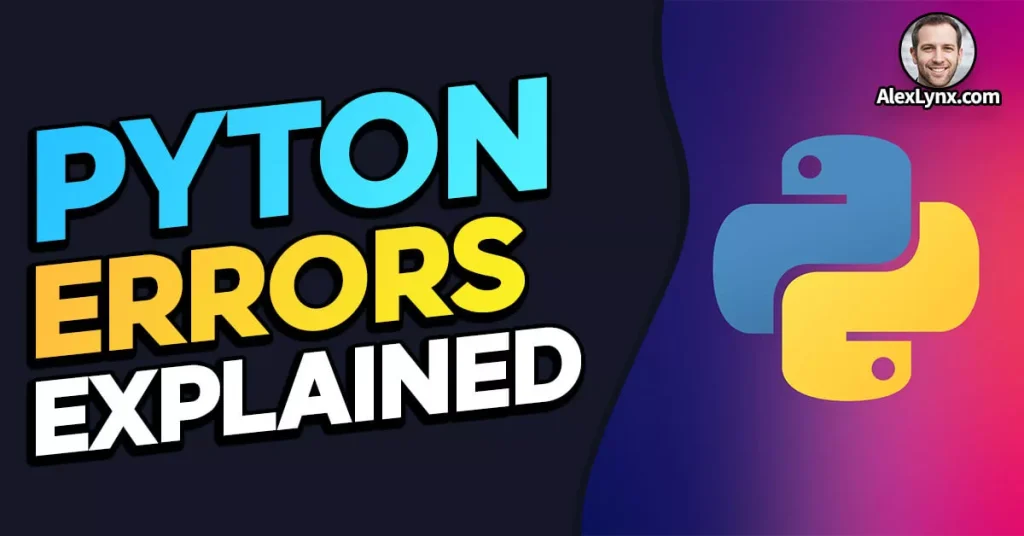Welcome to our blog post on resolving the notorious Python error: ValueError: invalid literal for int() with base 10. If you’ve encountered this error while coding in Python, fret not! We’ve got you covered with this comprehensive guide to help you overcome this frustrating hurdle and level up your Python programming skills.
Why Resolving This Error is Crucial
Imagine this: you’re working on a Python project, diligently writing code, and suddenly, you hit a roadblock – the dreaded ValueError: invalid literal for int() with base 10. This error occurs when you’re trying to convert a string to an integer using the int() function, but the string contains characters that cannot be converted into a valid number.
Fixing this error is essential for efficient Python programming because it ensures smooth data processing and accurate computations. Whether you’re a seasoned developer or a Python beginner, understanding and resolving this error will undoubtedly enhance your coding prowess.
Now, let’s dive deeper into the intricacies of this error and explore effective solutions.
Understanding the ValueError

Before we jump into the solutions, let’s take a moment to understand what the ValueError: invalid literal for int() with base 10 actually means.
Defining ValueError and Its Occurrence in Python
In Python, ValueError is an exception raised when a function receives an argument of the correct type but with an invalid value. In the case of invalid literal for int() with base 10, it specifically pertains to an error encountered during the conversion of a string to an integer using the base 10 numeral system.
This error commonly arises when you attempt to convert a string that doesn’t represent a valid numeric value. For instance, trying to convert “Hello, World!” into an integer would trigger this error since “Hello, World!” isn’t a valid numerical representation.
Causes of the “invalid literal for int() with base 10” Error
To help you understand the causes of this error, let’s explore a few scenarios that can lead to its occurrence:
- Non-numeric characters: When a string contains characters that are not valid numerals, such as letters, symbols, or whitespace.
- Incorrect formatting: If the string has incorrect formatting, such as missing or misplaced digits, decimal points, or commas.
- Empty strings: Attempting to convert an empty string, which lacks any numeric value, will also trigger this error.
Now that we’ve examined the root causes of the error, let’s move on to troubleshooting it and finding effective solutions.
(Keep reading for the troubleshooting steps and solutions in the next sections!)
Understanding the ValueError
Now that we have a solid grasp of what the infamous ValueError: invalid literal for int() with base 10 entails, let’s dive deeper into its intricacies and explore the causes that can lead to its occurrence.
Definition of ValueError and Its Occurrence in Python
In Python, ValueError is an exception that occurs when a function receives an argument of the correct type but with an invalid value. It acts as a signal that something went awry during the execution of your code, specifically in this case, while attempting to convert a string to an integer using the base 10 numeral system.
The int() function in Python is responsible for converting a given string into an integer. However, when the string contains characters that cannot be converted into a valid number, the ValueError: invalid literal for int() with base 10 is raised. This can throw a wrench into your coding journey, but fear not, as we’ll equip you with the knowledge to overcome it!
Causes of the “invalid literal for int() with base 10” Error
To better understand the causes behind this error, let’s explore a few scenarios that can trigger it:
- Non-numeric characters: Picture this scenario: you’re trying to convert the string
"OpenAI"into an integer. Now, we all know that “OpenAI” is a fantastic organization, but it simply doesn’t translate into a numerical value. The presence of non-numeric characters like letters, symbols, or whitespace within the string will lead to this error. - Incorrect formatting: Remember that the
int()function expects the string to have the proper formatting for a valid numerical value. If the string has missing or misplaced digits, decimal points, or commas, the conversion will fail, triggering theValueError. For example, attempting to convert the string"1,000,000"without removing the commas will result in this error. - Empty strings: Converting an empty string is like trying to extract juice from an empty fruit. It simply won’t work! Since an empty string lacks any numeric value, trying to convert it into an integer will inevitably raise the
ValueError: invalid literal for int() with base 10.
By understanding the root causes of this error, you can now navigate your way towards resolving it. But worry not, we’ve got you covered! In the next section, we’ll walk you through the troubleshooting process and provide you with effective solutions to conquer this error head-on. So, let’s proceed!
Troubleshooting the Error
Now that we understand the ins and outs of the ValueError: invalid literal for int() with base 10, it’s time to roll up our sleeves and tackle it head-on. Fear not, for we have a step-by-step troubleshooting process to guide you through resolving this pesky error.
Step 1: Identifying the Problematic Code Line
When faced with the ValueError: invalid literal for int() with base 10, the first step is to identify the line of code that triggers the error. The error message usually provides a traceback with information about the exact line where the error occurred. Locate this line in your code and proceed to the next step.
Step 2: Analyzing the Error Message
Next, let’s examine the error message itself. It contains valuable insights that can help us understand the underlying issue. Take note of the error message and any additional information provided, such as the specific value or string causing the error. This analysis will guide us towards an appropriate solution.
Step 3: Checking Input Types and Formats
One common culprit behind the invalid literal for int() with base 10 error is incorrect input types or formats. Ensure that you’re passing a valid string representing a numerical value to the int() function. Pay attention to the following:
- Remove any non-numeric characters from the string, such as letters or symbols.
- Verify that the string has the correct formatting for a numeric value, including decimal points, commas, or leading/trailing spaces.
- Double-check if the string is not empty. If it is, consider adding appropriate error handling to avoid the conversion.
Step 4: Handling Non-numeric Input Gracefully
It’s essential to handle scenarios where the input string contains non-numeric characters gracefully. You can implement input validation techniques, such as checking if the string is alphanumeric before attempting the conversion. By anticipating and handling non-numeric inputs, you can prevent the ValueError from occurring altogether.
Step 5: Converting Data Using the Correct Base
The int() function in Python allows you to convert a string to an integer using a specified base. By default, the base is set to 10. However, if you’re dealing with numbers in a different numeral system, such as binary or hexadecimal, make sure to provide the correct base parameter to the int() function. For instance, when converting a binary string to an integer, use int("11010", 2) instead of relying on the default base 10 conversion.
Step 6: Utilizing Exception Handling with Try-Except Blocks
Exception handling is a powerful technique to gracefully handle errors in Python. By utilizing try-except blocks, you can catch and handle the ValueError specifically, preventing it from halting the execution of your program. Wrap the problematic code segment within a try block and provide an except block to handle the ValueError exception. This way, you can implement custom error messages or alternative actions when the conversion fails.
By following these troubleshooting steps, you’ll be well-equipped to conquer the ValueError: invalid literal for int() with base 10 error in Python. However, prevention is better than cure, so in the next section, we’ll explore some best practices to avoid encountering this error altogether. Let’s keep the momentum going!
Best Practices for Avoiding the Error
Now that we’ve conquered the troubleshooting process for the ValueError: invalid literal for int() with base 10, let’s take a proactive approach and explore some best practices to avoid encountering this error in the first place. By following these guidelines, you can enhance the robustness of your code and minimize the likelihood of stumbling upon this pesky error.
Using Input Validation to Prevent Invalid Literals
Input validation is a powerful technique that helps ensure the validity and integrity of the data you’re working with. By validating user inputs or file inputs before attempting any conversions, you can prevent the occurrence of the invalid literal for int() with base 10 error. Here are a few tips for effective input validation:
- Check if the input is of the expected data type before performing any conversions. You can use functions like
isdigit()or regular expressions to ensure that the input consists only of numeric characters. - Implement conditional statements or loops to prompt users for valid inputs when they provide invalid literals. For example, if you expect an integer input, you can loop until the user enters a valid numeric value.
Implementing Data Type Checks and Conversions
In addition to input validation, it’s crucial to implement appropriate data type checks and conversions when working with user inputs or external data sources. Consider the following tips:
- Before performing any operations or calculations that require numeric values, validate and convert the input data to the appropriate data type. This way, you can catch any invalid literals before they cause issues later in your code.
- Use functions like
isnumeric()to check if a string represents a valid numeric value before attempting conversions. This helps you avoid unnecessary errors and ensures the reliability of your code.
Proper Handling of User Inputs and File Inputs
When dealing with user inputs or inputs from external files, it’s important to handle them properly to avoid unexpected errors. Here are a few guidelines:
- Always assume that user inputs or file inputs may contain invalid literals. Implement proper error handling techniques, such as try-except blocks, to catch and handle any potential errors gracefully.
- Provide clear instructions and error messages to guide users when they provide incorrect inputs. This will help them understand the expected input format and prevent them from encountering the
ValueErrorin the first place.
By incorporating these best practices into your coding workflow, you’ll greatly reduce the likelihood of encountering the invalid literal for int() with base 10 error. Remember, prevention is key to smooth and error-free Python programming.
In the next section, we’ll explore some common pitfalls to avoid and provide additional tips to enhance your Python programming skills. Stay tuned!
Common Pitfalls and Additional Tips
As you continue your journey towards mastering Python and conquering the ValueError: invalid literal for int() with base 10 error, it’s essential to be aware of some common pitfalls and gain additional tips to navigate through challenging scenarios. Let’s explore these to further enhance your Python programming skills.
Mistakes to Avoid While Fixing the Error
While troubleshooting and resolving the invalid literal for int() with base 10 error, it’s easy to stumble upon some common mistakes. Here are a few pitfalls to watch out for:
- Ignoring error handling: Neglecting proper error handling can result in unexpected crashes and make your code less robust. Always utilize exception handling techniques, such as try-except blocks, to catch and handle errors gracefully.
- Failing to analyze the error message: The error message provides crucial information about the error’s root cause. Be sure to analyze it carefully to pinpoint the problematic code and determine the appropriate solution.
- Skipping input validation: Neglecting input validation can lead to unexpected input values and trigger the
ValueError. Implement thorough input validation techniques to ensure the integrity of your data.
Debugging Techniques for Challenging Scenarios
In the realm of programming, debugging is a skill that can save you countless hours of frustration. Here are a few techniques to aid you in debugging challenging scenarios:
- Print debugging: Inserting print statements strategically in your code can help you trace the flow and identify potential issues. Print the values of variables or intermediate steps to gain insights into what’s happening during execution.
- Step-by-step debugging: Utilize integrated development environments (IDEs) that support debugging features. These tools allow you to set breakpoints and step through your code line by line, examining variable values and execution flow.
- Code review and pair programming: Engage with fellow developers or seek code reviews to benefit from fresh perspectives. Sometimes, a second pair of eyes can catch issues that you may have overlooked.
Recommended Resources for Further Learning
To expand your knowledge and proficiency in Python, here are some recommended resources worth exploring:
- Python documentation: The official Python documentation is an invaluable resource that provides in-depth explanations and examples for various topics, including error handling and data conversions.
- Stack Overflow: The popular question-and-answer website, Stack Overflow, is an excellent platform for finding solutions to specific programming challenges. You can search for similar error cases or ask your own questions to receive expert advice.
- Online tutorials and courses: Numerous online platforms offer Python tutorials and courses that cover error handling, data conversions, and more. Consider platforms like Udemy, Coursera, or Codecademy to enhance your Python skills.
Remember, continuous learning and practice are key to becoming a proficient Python programmer. Embrace these resources and keep honing your skills to become a coding maestro!
In conclusion, armed with a solid understanding of the ValueError: invalid literal for int() with base 10 error, along with the troubleshooting steps, best practices, and additional tips we’ve covered, you’re now well-prepared to tackle this error head-on. Remember to approach coding challenges with persistence, a sense of humor, and an appetite for continuous improvement. Happy coding!
Conclusion
Congratulations on successfully navigating through the world of the ValueError: invalid literal for int() with base 10 in Python! Let’s take a moment to recap the main points we’ve covered in this article and highlight the significance of resolving this error.
Recap of the Main Points
In this article, we embarked on a journey to understand and conquer the ValueError: invalid literal for int() with base 10 error. Here’s a quick recap of what we covered:
- We defined the
ValueErrorand explored its occurrence in Python, specifically when trying to convert a string to an integer using base 10. - We delved into the causes of this error, including non-numeric characters, incorrect formatting, and empty strings.
- We provided a step-by-step troubleshooting process, including identifying the problematic code line, analyzing the error message, checking input types and formats, handling non-numeric input gracefully, converting data using the correct base, and utilizing exception handling with try-except blocks.
- We highlighted best practices to avoid encountering the error, such as using input validation, implementing data type checks and conversions, and properly handling user inputs and file inputs.
- We discussed common pitfalls to avoid while fixing the error, along with debugging techniques for challenging scenarios.
- We shared recommended resources for further learning, including the Python documentation, Stack Overflow, and online tutorials and courses.
The Importance of Resolving the ValueError for Smooth Python Programming
Resolving the invalid literal for int() with base 10 error is crucial for achieving smooth and efficient Python programming. By understanding the causes behind the error and following the troubleshooting steps, you can ensure the integrity of your data, prevent unexpected crashes, and improve the reliability of your code.
By implementing best practices, such as input validation, proper data type checks, and thoughtful error handling, you can enhance the robustness of your programs and minimize the likelihood of encountering this error. These skills not only help you overcome this specific error but also contribute to your growth as a proficient Python programmer.
Remember, the world of programming is filled with challenges and opportunities for learning. Embrace each hurdle as an opportunity to expand your knowledge and refine your problem-solving skills. With persistence, practice, and a dash of humor, you’ll continue to progress on your coding journey.
Keep exploring, keep coding, and most importantly, keep having fun! May your Python adventures be filled with success and creativity. Happy coding!
FAQ
Why am I getting the “invalid literal for int() with base 10” error in Python?
This error occurs when you try to convert a string to an integer, but the string contains characters that cannot be converted to a valid number.
How can I fix the “invalid literal for int() with base 10” error?
To fix this error, you can check the input for non-numeric characters, ensure proper formatting, handle non-numeric input gracefully, use the correct base for conversion, and implement exception handling.
What is the importance of input validation in avoiding the “invalid literal for int() with base 10” error?
Input validation helps prevent the error by ensuring that the input string contains only valid numeric characters. It helps maintain the integrity of your data and reduces the chances of encountering this error.
Are there any debugging techniques I can use to resolve the “invalid literal for int() with base 10” error?
Yes, debugging techniques such as print statements, step-by-step debugging with breakpoints, and code reviews can help identify the problematic code line and understand the flow of execution, aiding in resolving the error.
Where can I find further resources to learn more about resolving the “invalid literal for int() with base 10” error?
You can refer to the official Python documentation for detailed explanations, explore relevant discussions on Stack Overflow, or enroll in online tutorials and courses to deepen your understanding of this error and its solutions.
References:



